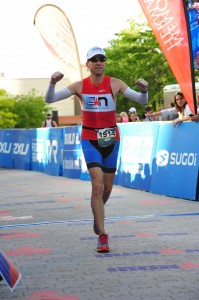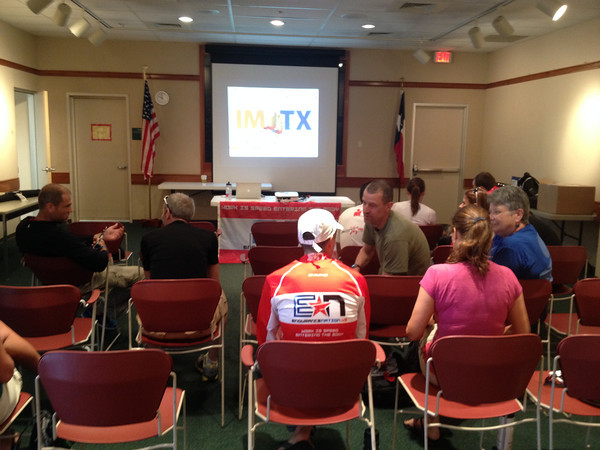Ironman® Race Execution: The Four Keys
 Over the past decade, we’ve developed a program of key elements to help guide our athletes to better performance and higher rates of success in the execution of their races. We’ve found that there are four elements that propel athletes forward, and they are based more on education and execution than on fitness and training.
Over the past decade, we’ve developed a program of key elements to help guide our athletes to better performance and higher rates of success in the execution of their races. We’ve found that there are four elements that propel athletes forward, and they are based more on education and execution than on fitness and training.
While all those elements are important to your overall success, the Four Keys of Ironman® Triathlon Execution are the most important pieces to the big picture puzzle. To introduce you to our principles, we’ve created a free Ironman® Execution email seminar, newly updated for 2014, that guides you through all the concepts you need to grasp to increase your performance. This seminar is a text version of our Live Four Keys Talks that we hold at key Ironman® races throughout the season.
We’d like to give you a taste of the Four Keys with our free email course.
Key #1: Execution, not Fitness
Summary: All you’ve done for 9 months is build a vehicle. Ironman® and Half Ironman® racing is about how you DRIVE that vehicle, it is NOT about the vehicle itself.
On race weekend, the host city of an Ironman® is the fittest city on the planet, no doubt. Ironman® athletes are very, very fit people who’ve done a lot of very hard work to toe the starting line. And yet when you fast forward the day to about mile 18 or 20 of the run, what stands out most starkly to the observer is just how badly many of these very, very fit people are struggling.
Why is that?
The culture of Ironman® is very training, fitness, and gear oriented. Conversations about how to train, how to build fitness, and what $500 carbon widget to hang off your bike dominate the space. This leads to the perspective that Ironman® is a 140 mile problem that is solved through the brute force application of fitness to the day.
This is 100% wrong and results of that line of reasoning are evident on race day, in the form of very, very fit people walking, shuffling, staggering, or under a bush later in the run.
The fact is that 140 miles is too big of a problem for anyone to solve through the application of fitness alone. Understand that all you’ve done with your four, six, nine or more months of training is build a fitness vehicle. Ironman® is then about driving that vehicle smartly for 140 miles around the course. In short,
Race day is about execution, not fitness
When you adopt this perspective on the what the day is about, you’ll open your eyes to how other people race vs how they should be racing. And it becomes very clear that only about 10-15% of the field actually know how to race. This is so true that we could probably distill the remainder of this seminar series to
Pretty much everyone doesn’t know how to race. Just do the opposite of what everyone else is doing, all the time, and you’ll be fine!
Just Riding Along (JRA) during the first thirty to forty five minutes of the bike, as everyone else blasts past you? That’s a good thing.
Going backwards on a hill as everyone else charges up it? That’s a good thing
Are you the only person not running sub 3:30 pace in the first four miles of the marathon? That’s a good thing.
Key #2: The Line
Summary: Nothing on race day really matters until you reach The Line on the run. The Line is the point at which continuing becomes very, very difficult. You define success as simply not slowing down at The Line.
If the key to a successful race is execution, not fitness, we need to define what a successful race is. And it helps to step back and observe how most Ironman® races play out. To step back from the gaming table and observe which strategies win, which lose, and where are the key decision points.
The Endurance Nation coaches have nearly 30 Ironman® finishes between them. We’ve been to countless Ironman® events and we’ve put thousands and thousands of athletes across Ironman® finish lines over the years.
This is what we know:
Most Ironmans go south at a line, The Line, on the run where it suddenly becomes very, very difficult to continue your pace. Nothing on race day really matters until you reach The Line, because if you have screwed up before The Line, you will go backwards to the tune of 7 to 10 minutes per mile. This effect is so drastic, and consequences for failure are so big, that it frames our definition of a successful Ironman:
Success = Not Slowing Down on the Run
Race day is then about the proper application of your fitness to the race, via excellent race execution skills, in order to create the conditions for success at the key decision point of the day: The Line, or about Mile 18. Success at or after the line isn’t going faster…it’s not slowing down!
Nothing you do before The Line really matters but everything you do before The Line is about creating conditions for success at The Line = Not. Slowing. Down!!
Below are few cues we’d like to put into your head to help you maintain this Line-focused perspective:
Don’t be a bad-ass before the Line
Here’s the deal: at some point of the day, usually at or after the Line, it’s going to suck. It’s going to suck very, very badly. All you do by trying to make something happen, by trying to be a badass, is to bring that Suck closer to you. We can each only deal with The Suck for so long. Our observation is that most of us have about 8 miles of Extreme Suck Endurance inside our heads. If you put yourself in The Suck for longer than that, your failure rate increases dramatically. So before the line, you’re racing in a Fairies and Unicorns Place — you’re happy, you’re relaxed, you’re not expending your Mental Badass Points on the easy stuff. After The Line…engage your Badass. Get mean, get angry, get it done. But before The Line, just relax!
There is no such thing as a good bike followed by a poor run
How does that bike split look as you walk the last 10 miles of the marathon?
Ride your “should” bike split vs your “could” bike split
Your Could split is what you tell Timmy you could ride on a good day, when you’re out together for your last ride before the race. If you say you “could ride a 5:50,” your Should split is likely 6:00, and is defined as the bike split that yields a good run.
Think you made the mistake of riding too easy? You now have a 26 mile run to fix that mistake
Make the mistake of riding too hard? That mistake now has 26 miles of very hard running to express itself, to the tune of X miles at 17-18′ walking pace vs X miles at 8-10′ running pace. Do the math. Again, how is that bike split going to look as you are walking/shuffling the last 10 miles of the run?
Key #3: The Box
Summary: All day long you are going to race inside a Box. Inside the Box are things you can control. Outside of the Box is everything you can’t control. Keep the Box as big as you can for as long as you can.
You execute good decisions within this Box and everything is framed as:
“What do I need to do right now to create the conditions for success at The Line?”
Your goal is to also keep this Box as big as you can for as long as you can:
- On the swim, the Box is the space your body occupies in the water: focus on your form and the rest will come.
- On the bike, the Box is probably about the length of time until the next aid station, or about 30-40 minutes. From what we’ve seen first hand on the IM courses this season, we believe you should ask yourself “Am I participating in some short-term tactical masturbation,” particularly on hills. Why are you so concerned with the 5 bike lengths that a guy has opened up on you on a hill at mile 60 of the bike, when you still have to ride 52 miles AND run a marathon!
- On the run, the box begins as 2-3 aid stations long but often diminishes to “from here to the next lamp post/manhole cover/mail box.” If the Ironman® run has conspired to distill your Entire Universe down to the next thirty seconds (it happens, trust us), that’s fine. Just do the best you can, make the best decisions you can, within your Thirty Second Universe.
Key #4: The One Thing
Summary: prepare yourself for the mind / body debate by identifying your One Thing — why are you racing Ironman?
So…you’ve done everything right. You show up at The Line have created conditions for success. You’ve called down to the engine room to engage the Badass Drive…but you get a little lip back:
“Hey, Jack, you’ve had me out here for 9, 12, 14 hours. I feel like an evil man has been beating me all day with a stick. I’m going to slow down and there is nothing you can do about it!”
The Body begins to debate the Head with some very, very strong arguments! This is when you reach into your Suitcase of Courage and lay your One Thing on the table.
The One Thing.
Before the race, you need to ask yourself “Why am I doing Ironman?” You need to determine what is the One Thing that put you in this race? To finish in the daylight with a smile on your face? To run a 4:10? Whatever your One Thing is, be absolutely clear and rehearse your mind/body debate beforehand.
But be warned: your body can be a helluva good negotiator at mile 18, especially if your mind hasn’t prepared its rebuttal arguments beforehand. And it helps to have One Things A, B, and C lined up! Whatever, just don’t wing it!
Four Keys Review
- Race day is about execution, not fitness.
- Proper execution is that which sets up a good run, which we define as not slowing down.
- That slowing down happens at the Line.
- I drive my Fitness Vehicle to the Line by putting my head in a Box.
- Within the Box are things I can control. Everything else, things I can’t control right now, are outside of the Box.
- Within the Box I’m focused on making good decisions, which are framed as those which create conditions for success on the run, which is, again, defined as not slowing down.
- Within the Box I’m relaxed, happy, fairies and unicorns. I’m not a Badass, trying to make something happen. Doing so only brings me to The Suck sooner.
- Only at The Line do I begin to go to work.
- And when it gets hard, when The Suck happens, that’s when I engage my One Thing — why am I here, why am I doing this to myself (!!), what is my Mind’s rebuttal to my Body’s debate?




Leave a Reply